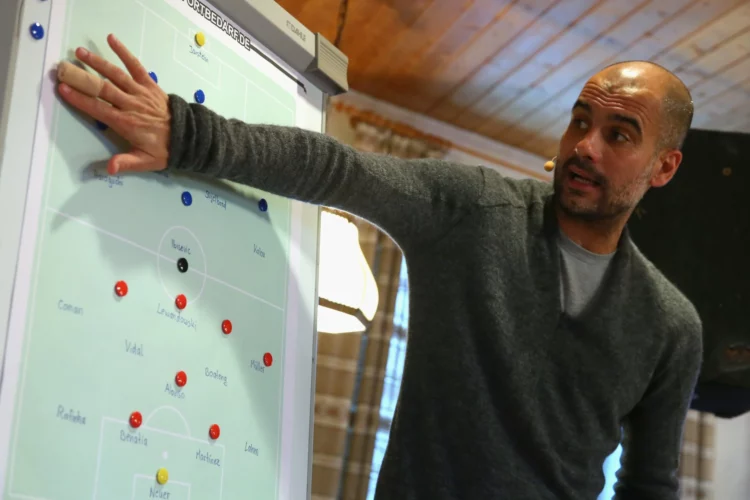Football, a game where strategic depth matches physical prowess, sees its finest contests often decided by the acumen of its coaches. The role of a coach transcends training athletes; it involves intricate planning, game reading, and tactical adaptability. This article explores the top 10 football tactics used by successful coaches. These methods demonstrate how a blend of preparation, in-game decisions, and player management can culminate in a successful team. We will delve deeply into each tactic, explaining their importance and execution.
10. High Pressing Game
High pressing is a tactical approach favored by coaches aiming to stifle their opponents early and create turnover opportunities that lead to goal-scoring chances. This aggressive method is effective in pinning opponents in their half, disrupting their usual play patterns.
Key Elements:
- Immediate Pressure: Players are instructed to swarm the ball-carrier immediately after possession is lost, creating pressure scenarios that lead to mistakes.
- Team Coordination: Effective high pressing requires synchronized movements from all outfield players, who must understand when to press and when to retreat.
- Physical Demand: Players need exceptional conditioning to implement this tactic throughout a game, as it requires sprinting, closing down spaces, and continuous alertness.
Detailed Application:
- Training Drills: Coaches often run drills that simulate scenarios where players must quickly transition from attack to defense, emphasizing stamina and speed.
- Video Analysis: Teams analyze opponent tendencies to predict play patterns, ensuring high pressing can be effectively targeted.
9. Tiki-Taka Possession Play
Tiki-Taka involves maintaining possession with short, quick passes and excellent player movement. It requires players to be technically proficient and highly disciplined in maintaining structure and spacing.
Key Elements:
- Passing Accuracy: Precision in passing under pressure is crucial, as the tactic fails with poor execution.
- Spatial Awareness: Players must be constantly moving, offering passing options and creating spaces by dragging opponents out of position.
- Controlled Tempo: The team dictates the match’s pace, slowing it down or accelerating play based on the situation.
Detailed Application:
- Skill Development: Coaches focus heavily on developing players’ technical skills, particularly in passing and first-touch control.
- Positional Play Drills: Practices are designed around enhancing players’ understanding of their roles in various field zones, improving decision-making.
8. Counter-Attacking Football
This tactic leverages speed and space, focusing on quick transitions from defense to attack. It is particularly effective against teams that commit many players forward, leaving them vulnerable to breaks.
Key Elements:
- Rapid Transition: The essence of a counter-attack lies in the speed of turning defense into an offensive opportunity.
- Targeting Space: Players exploit the spaces left by advancing opponents, using speed and direct routes towards goal.
- Clinical Finishing: Efficiency in front of goal is crucial, as counter-attacks often provide limited scoring opportunities.
Detailed Application:
- Strategic Positioning: Coaches train players to recognize when to hold their positions and when to explode forward in a coordinated manner.
- Stamina and Speed Training: Conditioning programs are tailored to enhance players’ ability to sustain high-speed runs and recover quickly.
7. The Flexible 3-5-2 Formation
The 3-5-2 setup offers tactical flexibility, providing strength in defense and options in midfield and attack. It adapts well to different phases of play, supporting both defensive solidity and offensive width.
Key Elements:
- Central Strength: Three central defenders offer robust protection and the ability to play out from the back.
- Wing-Backs’ Dual Role: They provide width, supporting attacks and retreating quickly to defend, crucial for balancing the formation.
- Midfield Control: With three central midfielders, teams can dominate the central areas, supporting both defense and attack.
Detailed Application:
- Role Specialization: Coaches often train players in specific roles, ensuring that wing-backs, for example, are adept both defensively and offensively.
- Tactical Flexibility Drills: Practice sessions include scenarios that shift the formation to 5-3-2 or 3-4-3, preparing players for in-game tactical changes.
6. Set-Piece Excellence
Set-pieces are a critical part of football, offering structured opportunities to score or defend crucial plays. Mastery of set-pieces can be a game-changer in closely contested matches.
Key Elements:
- Innovative Routines: Developing creative and unpredictable set-piece routines can catch opponents off-guard.
- Player Roles: Each player has a specific role, whether as a decoy, blocker, or primary target, maximizing the effectiveness of each set-piece.
- Rehearsal: Regular practice of set-piece scenarios ensures players are familiar with their roles and timing.
Detailed Application:
- Specialist Coaches: Some teams employ set-piece coaches to develop and oversee these plays, reflecting their strategic importance.
- Player Selection: Selection for set-pieces is strategic, with particular roles (e.g., aerial threats, precise deliverers) assigned based on player skills.
Read More: Top 10 Emerging Football Talents to Watch
5. Defensive Organization
A well-organized defense forms the foundation of a successful team strategy. Coaches emphasize structure, discipline, and communication among defensive players to minimize scoring opportunities for opponents.
Key Elements:
- Defensive Drills: Regular drills that focus on defensive positioning, tackling, and intercepting.
- Communication: Ensuring that all players are continually talking, calling out formations, and changes in defensive tactics.
- Mental Toughness: Training players to maintain focus and composure, especially under pressure.
Detailed Application:
- Scenario Training: Simulations of various attacking threats are used to prepare defenders for different types of opponents.
- Video Analysis: Detailed reviews of previous matches help identify defensive lapses and areas for improvement.
4. Attacking Overloads
Creating numerical advantages in specific areas of the pitch allows teams to dominate those zones and increase their chances of scoring. This tactic requires dynamic player movement and versatile skill sets.
Key Elements:
- Dynamic Positioning: Players must be adept at recognizing when and where to create overloads, moving fluidly to exploit weaknesses.
- Versatility: Players capable of performing multiple roles can seamlessly switch positions to create mismatches.
- Training for Creativity: Encouraging creative play and improvisation in training can lead to effective overload situations in matches.
Detailed Application:
- Tactical Games: Mini-games during training that focus on creating and resolving overloads, enhancing players’ tactical understanding.
- Player Analytics: Using data to analyze the effectiveness of overloads and to identify which players perform best in these scenarios.
3. Width and Crossing
Utilizing the full width of the pitch stretches the opposition’s defense and opens up channels for crossing into the penalty area. This tactic is fundamental for teams that have strong aerial presence in the box.
Key Elements:
- Wing Play: Effective use of wingers or fullbacks to stretch the defense and deliver crosses.
- Crossing Accuracy: Emphasis on the quality of crosses, aiming to match the attackers’ movements.
- Aerial Ability: Forwards and attacking midfielders with strong aerial skills are crucial for converting crosses.
Detailed Application:
- Crossing Drills: Specific training focused on the timing and precision of crosses from various angles.
- Positional Play: Ensuring that attacking players are adept at finding space in the box and timing their runs to meet crosses.
2. Psychological Preparedness
Mental fortitude is as vital as physical readiness. Coaches instill a psychological edge by preparing teams to handle various game pressures, maintaining focus throughout the match, and adapting to unforeseen circumstances.
Key Elements:
- Mental Conditioning: Programs designed to enhance mental resilience, focus, and team cohesion.
- Pre-game Routines: Establishing routines that help players mentally prepare for games, maintaining consistency regardless of the opponent or stakes.
- In-game Communication: Encouraging on-field leadership and communication to keep the team mentally aligned and focused.
Detailed Application:
- Sports Psychologists: Many teams work with sports psychologists to develop mental toughness and handle the psychological aspects of competition.
- Leadership Training: Developing leadership qualities in players, ensuring there are multiple leaders on the field who can maintain team morale and focus.
1. Adaptability and In-Game Management
The top tactical trait of successful coaches is their ability to adapt to the evolving nature of a match. This involves making timely decisions, such as tactical shifts and substitutions, to counter the opponent’s strategies and exploit new opportunities.
Key Elements:
- Tactical Flexibility: The ability to change tactics or formations mid-game to adjust to the flow of the match and opponent adjustments.
- Decisive Substitutions: Making impactful changes with substitutes who can alter the dynamics of the game.
- Match Analysis: Real-time analysis and communication of tactical observations to make informed decisions.
Detailed Application:
- Scenario-Based Training: Preparing for various game scenarios, including being ahead, behind, or at numerical disadvantages.
- Real-Time Data Use: Leveraging data analytics during the match to make informed tactical changes.
Conclusion
In the realm of football, the tactics employed by successful coaches serve as the linchpin for victory. Football tactics used by successful coaches encapsulates a strategic framework where preparation, adaptability, and teamwork converge to shape the outcome on the pitch. From the relentless pressure of high pressing to the precision of tiki-taka possession play, each tactic underscores the importance of cohesive execution. Mastery of these tactics not only hones individual skills but also fosters a collective mindset of resilience and innovation. In the ever-evolving landscape of football, coaches who adeptly navigate the dynamics of a match through astute in-game decisions and adjustments emerge as the true architects of triumph.




